The CRSN team has developed this series of infographics to help you better understand some of the common concerns following a stroke. Click on a topic below to view or print the infographic. They are listed alphabetically. Please note that all infographics are also available on the French side of this website.
See additional stroke resources and videos
Find COVID-19 pandemic resources for stroke survivors, families, and caregivers
The Infographics:
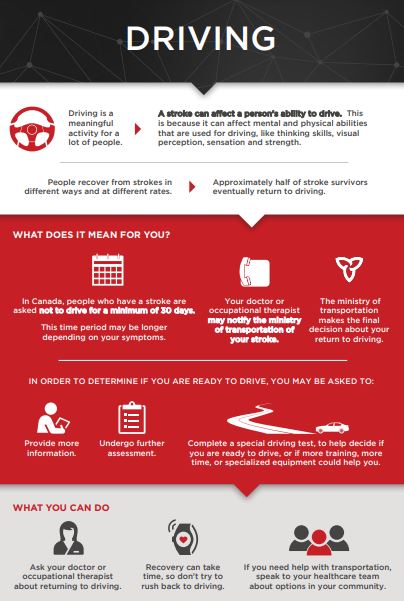
(sample)
 Advance Care Planning Preparing an advance care plan can ensure that you receive treatment that honours your values and wishes.
Advance Care Planning Preparing an advance care plan can ensure that you receive treatment that honours your values and wishes.
 Balance and Falls Post Stroke About 40% of all stroke survivors will fall within the first year.
Balance and Falls Post Stroke About 40% of all stroke survivors will fall within the first year.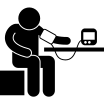 Blood Pressure Monitoring at Home Measuring your blood pressure at home is one of the best ways to know if it is under control.
Blood Pressure Monitoring at Home Measuring your blood pressure at home is one of the best ways to know if it is under control.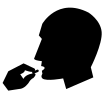 Blood Pressure Medication Information High blood pressure is the number one risk factor for stroke.
Blood Pressure Medication Information High blood pressure is the number one risk factor for stroke. Changes to Emotions and Mood Approximately one-third to two-thirds of stroke survivors will experience depression.
Changes to Emotions and Mood Approximately one-third to two-thirds of stroke survivors will experience depression. Communication Aphasia, speech problems and cognitive-communication problems.
Communication Aphasia, speech problems and cognitive-communication problems. Delirium is a suddenly confused state of mind. Delirium is common in acute stroke. (Credit: The Ottawa Hospital and the Champlain Region Patient, Family and Caregiver Education Program)
Delirium is a suddenly confused state of mind. Delirium is common in acute stroke. (Credit: The Ottawa Hospital and the Champlain Region Patient, Family and Caregiver Education Program)  Driving A stroke can affect the mental and physical abilities that are needed for driving.
Driving A stroke can affect the mental and physical abilities that are needed for driving. Exercise and Mobility Exercise is an important part of recovery and can reduce your risk of having another stroke by about 30%.
Exercise and Mobility Exercise is an important part of recovery and can reduce your risk of having another stroke by about 30%.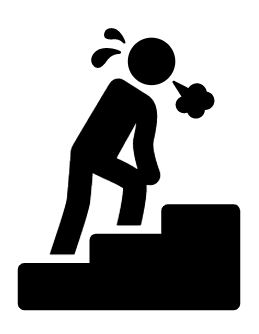 Fatigue Post Stroke is intense tiredness that isn’t always related to how active you’ve been and does not improve as quickly with rest.
Fatigue Post Stroke is intense tiredness that isn’t always related to how active you’ve been and does not improve as quickly with rest. Healthy Eating The food we eat can play an important part in preventing a stroke.
Healthy Eating The food we eat can play an important part in preventing a stroke.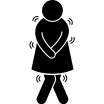 Incontinence With lifestyle changes and treatment, about 80% of incontinence problems can be resolved.
Incontinence With lifestyle changes and treatment, about 80% of incontinence problems can be resolved. Medication - Taking your Medications After a stroke or a mini-stroke, your risk of having another stroke is higher.
Medication - Taking your Medications After a stroke or a mini-stroke, your risk of having another stroke is higher.
 Medication - Apixaban (Eliquis®) Apixaban is an oral anticoagulant, often called a “blood thinner”.
Medication - Apixaban (Eliquis®) Apixaban is an oral anticoagulant, often called a “blood thinner”.
 Medication - Aspirin Your doctor prescribed baby aspirin to keep blood clots from forming.
Medication - Aspirin Your doctor prescribed baby aspirin to keep blood clots from forming.

 Medication - Dabigatran (Pradaxa®) Dabigatran is an oral anticoagulant, often called a “blood thinner”.
Medication - Dabigatran (Pradaxa®) Dabigatran is an oral anticoagulant, often called a “blood thinner”. Medication - Edoxaban (Lixiana®) Edoxaban is an oral anticoagulant, often called a “blood thinner”.
Medication - Edoxaban (Lixiana®) Edoxaban is an oral anticoagulant, often called a “blood thinner”. Medication - Rivaroxaban (Xarelto®) Your doctor prescribed rivaroxaban to keep blood clots from forming.
Medication - Rivaroxaban (Xarelto®) Your doctor prescribed rivaroxaban to keep blood clots from forming. Medication - Statins Your doctor prescribed a statin to lower cholesterol and avoid stroke or heart attack.
Medication - Statins Your doctor prescribed a statin to lower cholesterol and avoid stroke or heart attack. Medication - Warfarin (Coumadin®) Your doctor prescribed warfarin to keep blood clots from forming.
Medication - Warfarin (Coumadin®) Your doctor prescribed warfarin to keep blood clots from forming.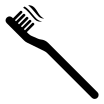 Oral Health Poor oral health is linked to serious health problems.
Oral Health Poor oral health is linked to serious health problems. Pain About a third of all stroke survivors will experience pain.
Pain About a third of all stroke survivors will experience pain.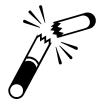 Quitting Smoking Smoking can increase your risk of stroke by as much as three times.
Quitting Smoking Smoking can increase your risk of stroke by as much as three times.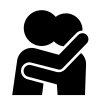 Sexuality Post Stroke Up to 75% of stroke survivors will experience a change in their ability and/or desire to return to sexual activity.
Sexuality Post Stroke Up to 75% of stroke survivors will experience a change in their ability and/or desire to return to sexual activity.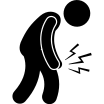 Spasticity is increased activity or “tone” in your muscles making them feel stiff and tight.
Spasticity is increased activity or “tone” in your muscles making them feel stiff and tight. Visual Field Deficit One-third of stroke survivors will have some loss of vision.
Visual Field Deficit One-third of stroke survivors will have some loss of vision.
